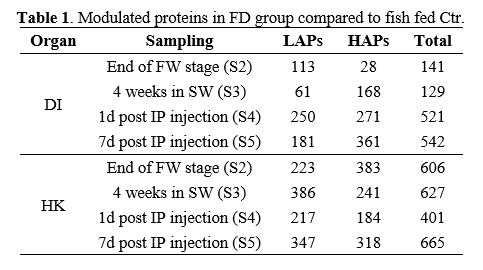PROTEOMIC ANALYSIS REVEALED POTENTIAL HEALTH EFFECTS OF FUCOIDAN FROM SUGAR KELP Saccharina latissima IN VACCINATED ATLANTIC SALMON Salmo salar
Introduction
Salmonid products represent ~ 20% of global seafood exports by value. P rojections from the Food and Agriculture Organization indicate that fish farming will continue to expand in the coming decades (FAO, 2024). However, high mortality rates – driven by m ulti-stressor conditions (e.g., infectious diseases and environmental problems), remain a significant challenge in major salmonids producing countries such as Norway and Chile. To address this problem, the combin ation of vaccines and functional feeds with bioactive additives is a strategy that has gained interest in recent years. I n the Resilient s almon project (RCN 294821) we aim to improve the immune response of Atlantic salmon (Salmo salar ) against Tenacibaculum maritimum , a bacterial skin pathogen that threatens Norwegian aquaculture , and for which no commercial vaccines currently exist.
To achieve our goal, we combined a specific nutritional program with novel feeds containing fucoidan from sugar kelp (Saccharina latissima) during freshwater (FW) stage , along with a commercial pentavalent vaccine that do not contain T. maritimum antigens. Previously, we have described how fucoidan fractions are able to modulate the expression of immune-related genes in salmon head kidney cells (Michalak et al, 2023) . We also reported that vaccinated Atlantic salmon fed fucoidan up-regulated and increased the protein level of antimicrobial peptides (e.g., hepcidin and cathelicidin2 ) in head kidney after stimulation with inactivated T. maritimum (by intraperitoneal injection) in seawater (SW) stage. However, further characterization is needed to understand the bioactive properties of fucoidan in fish. Therefore, in the current study, a proteomic approach was used to analyze the potential health effects of this compound in the distal intestine and head kidney of Atlantic salmon.
Materials and Methods
At the NMBU’s Center for Fish trials, pre-smolt Atlantic salmon were vaccinated with ALPHA JECT micro 6 vaccine (PHARMAQ) . The n, fish were distributed into 300 L tanks (45 fish per tank) supplied with recirculated FW . Each tank (in duplicate ) was assigned to a commercial-like diet (Ctr ) or an experimental diet containing 0.2% fucoidan extract from sugar kelp (FD) for four weeks . After this period, 35 fish per tank were transferred to the SW facilities at the Norwegian Institute for Water Research (Solbergstrand , Norway) and fed the Ctr for the reminding experiment. After four weeks in SW , fish were intraperitoneally (IP) injected with inactivated T. maritimum . Samples from distal intestine (DI) and head kidney ( HK) were collected from six fish per tank at different time points: end of FW stage (S2) , after four weeks in SW (S3), one day post IP injection (S4) and seven days post IP injection (S5). T otal proteins were obtained from each sample and then quantified with the BCA method. To perform a proteomic analysis, six protein samples from each organ, dietary group and sampling were digested and analyzed through mass spectrometry by the Proteomics Unit at University of Bergen (PROBE) according to Mensah et al (2025). Raw data files were processed by Perseus v.1.5.6.0 (MaxQuant) . Thereafter, Limma v.3.61.9 was used in RStudio to determine the differentially modulated proteins between dietary groups. A contrast matrix between the FD and Ctr was created, and the significantly modulated proteins (p-value < 0.05) were determined. Modulated proteins (LAP: low abundance proteins; HAP : high abundance proteins ) were used for a functional analysis by KEGG mapper (Pathways and Brite databases) according to Purushothaman et al (2024) . Our study presents the results in which four or more hits were detected per term.
Results and Discussion
Overall, the comparison of proteomic data from fish fed FD and Ctr revealed that HK had a higher number of modulated proteins (LAPs and HAPs) than DI (Table 1). In addition, after t he functional analysis of these proteins, DI from S2 had LAPs related to glycosaminoglycan binding proteins , whereas HK at the same sampling point showed HAPs linked to transcription machinery, cell adhesion molecules , cytoskeleton proteins, cytokine receptors , chaperones and folding catalysts (among others) . This suggests that the dietary inclusion of fucoidan can modulate a primary lymphoid organ such as HK, which is involved in the coordination of local and systemic immune responses.
After the stimulation with inactivated T. maritimum , both DI and HK had HAPs associated with CD molecules and transporters at 1d post IP injection (S4). Also, HAP-related pathways such as endocytosis and antigen processing and presentation were detected in HK, while neutrophil extracellular trap formation , NOD-like receptor signaling, as well as complement and coagulation cascades were detected in DI. By contrast, S5 showed LAPs in DI linked to transcription factors and cytokine receptors, and LAPs in HK such as chaperones and folding catalysts , proposing a regulation of the response seven days post IP injection.
Conclusions
The inclusion of fucoidan in functional feeds for vaccinated Atlantic salmon pre-smolts showed the modulatory capacity (at the phenotypic level ) of this compound in DI and HK. Interestingly, after seawater transfer and 1d post- IP stimulation with inactivated T. maritimum , f ish previously fed fucoidan in FW exhibited enhanced health-related responses in SW, which declined 7 days post-IP stimulation.
References
FAO. 2024. The State of World Fisheries and Aquaculture 2024 – Blue Transformation in action. Rome.
Mensah DD, Morales-Lange B, Rocha SDC, et al. Paecilomyces variotii improves growth performance and modulates immunological biomarkers and gut microbiota in vaccinated Atlantic salmon pre-smolts. Fish Shellfish Immunol. 2025; 160:110223.
Michalak L , Morales-Lange B, Montero R, et al . Impact of Biorefinery Processing Conditions on the Bioactive Properties of Fucoidan Extracts from Saccharina latissima on SHK-1 Cells. Algal Res. 2023; 75:103221.
Purushothaman K, Crawford AD, Rocha SDC, et al. Cyberlindnera jadinii yeast as a functional protein source: Modulation of immunoregulatory pathways in the intestinal proteome of zebrafish (Danio rerio ). Heliyon. 2024; 10(5):e 26547.
